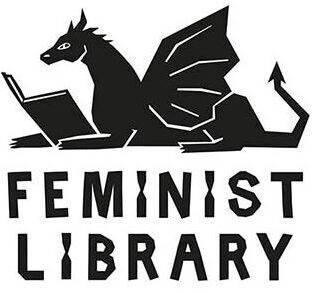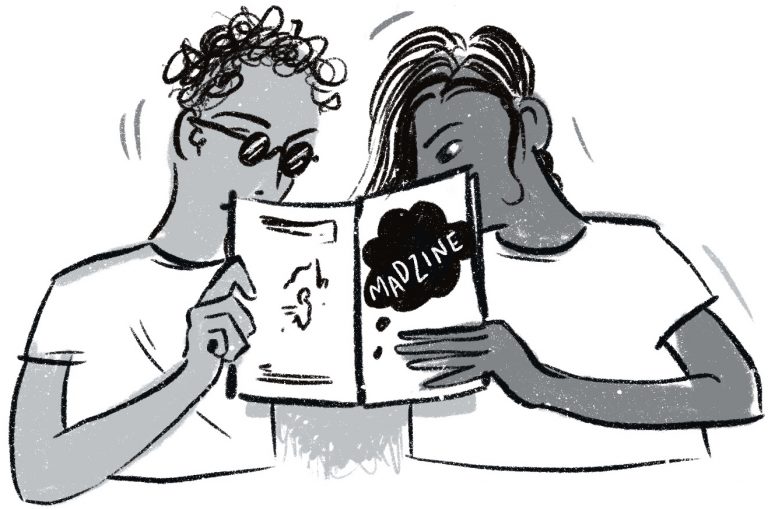In one form or another
In one form or another
Writer and researcher Anita Slater looks into MadZines, a project exploring and collecting zines that ‘craft contention’ around mental health
If you’ve ever filled out a form at your local GP, picked up a prescription, or sceptically scanned a diagnostic questionnaire online, you’ll be well aware of the different forms pervading our medical daily lives. For you and I- the ‘service users’ -the forms we encounter or fill out come in many different ‘forms’ and often seem tangential to a meeting with a mental health professional or diagnosis. Yet, the form that information or expression is contained in has a dramatic effect on how we see our own bodies and minds, and how mental health services see us.
As a form of making or writing, zines are an acute material disruption to the status quo, self-published material lending itself to questioning social norms and rules. As visual anthropologist Tamara Hart says, ‘Beginning as political pamphlets of the abolitionist era and adopted by feminist, punk, queer anti-racist movements’, they lie often explicitly on the fringes, working against generalisations and the ‘filing away’ of differences between people.
Zines have been impactful in questioning the assumptions around mental illness and the processes attached to mental health services. MadZines is a particularly fascinating project in this regard, funded by Wellcome and started by University of Central Lancashire based researchers Dr Helen Spandler and Dr Jill Anderson, and connected to student Tamsin Walker’s doctoral research. In Spandler’s own words, ‘Madzines are basically DIY produced zines that we think “craft contention” about how madness and distress is understood and treated. So we’re interested in the ways that zines might challenge common perceptions about things like diagnosis, medication, as well as policies and practices. We are especially interested in zines crafted by people with lived experience, usually psychiatric survivors’.
MadZines is building a connection between the spaces of academia and activism, working against the jelly-ringed slogans of the well-being industry by connecting zine-making to the growing discipline of Mad Studies. However, this connection can come with its own risks, can zines being folded into academic institutions dilute their position on the fringes? I asked Spandler this question: ‘there is a tension at the heart of zine culture (and any counter-cultural politics) – about wanting to change mainstream society, but also wanting to remain on the edges’. This echoes the concerns of queer theorist Robyn Weigman back in 2012, who in a chapter named ‘The Vertigo of Critique’ critically lamented the field of queer studies, wondering whether a field whose foundation lay in resisting (hetero)normativity could resist a dependence on the very thing it reacted and responded against.
However, through responding, new ideas and different perspectives constantly and consistently emerge. As Spandler says, ‘whenever zines become too institutionalised, they will re-emerge again in a different way, I guess that’s the beauty of the form!’ For example, MadZines collaborated with visual researcher Tamara Hart and artist Pops comix to put on a workshop at the Feminist Library. Surrounded by the library’s variety of writing forms such as zines, journal articles, protest archives, and poems, Hart discussed ‘this zine and self publishing practice as a form of looking at vulnerability as something that is a strength and tenderness as a tool for social action.’ Making their own ‘mad zines’, participants were encouraged to think about their experiences within mental health spaces, creating ‘hand-written poems, ribboned borders, myspace links, and postal addresses, each zine was a visual poesis of psychiatric survivorship.’
Engaging the space of the library, the mental health institution, and the artist makes for powerful interconnectivity between seemingly disparate areas. In an explicitly material blending of everyday forms, many of Hart’s workshop participants created alternative resources and guides for coping with mental illness that they felt weren’t available in existing spaces. Spandler tells me of the growing library collection being developed by the MadZines team, containing works such as ‘Rachel Rowan Olive’s A is for Awkward, an A to Z of the absurdities of the mental health system, and it’s no wonder that ‘E’ stands for evaluation forms’, and also I would say no surprise that the zines are ‘more real and relatable than the standardised forms and leaflets’ found in mental health clinics or medical websites.
MadZines is a truly novel project for anyone interested in the weaving together of different forms of writing, not only in relation to how zines typically subvert classic book forms, but also in how the project engages the different visual and written forms of everyday medical spaces. A focus on perzines (personal zines reflecting one’s own experience) through the project resists the temptation of mental health institutions to collapse different mental illnesses into one another, and also to neglect to see solidarities and connections. Engaging with writing forms such as surveys, guides, and textbooks brings a critical (and a creative) focus to what I call in my own doctoral research ‘guided forms’, meaning the forms and styles of writing that subtly ‘guide us’ in our every day lives to learn and think in designated ways. In this way, zines might introduce a kind of ‘critical guiding’, a way of problematising the linear directions we are expected and guided to take on a path through mental ‘health’.
However, it’s worth noting that something being labelled a zine doesn’t automatically make it a subversion or a critical take on an existing mainstream issue. For example, Spandler discusses ‘how there are loads of self-care zines out there, many of which are great, but some just seem to mirror the conventional well-being agendas’. Also, the format of zines doesn’t always lend itself to expressing the complicated ideas and experiences of the writer or creator, the ‘conventional mini-zine format’ Spandler says can feel too closed or compact for some people. In some senses, the very ‘unguided’ nature of zines, the emphasis on the freedom to create in any way you choose can deter people unsure of their artistic or written skills or interests. However, a variety of options for zine-making can make people realise they have been unintentional zine-makers all their lives.
When getting lost in the wildness of zines, how can we make them stick in the social imaginary? Sometimes this ‘sticking’ doesn’t have to be a physical thing, Hart tells me of their first experience of a zine being in a summer camp in Canada, a ‘coming of age’ zine experience where zine-making was attached to feelings of adolescence, nostalgia and friendship. Bringing these zine-memories into current creative practice can be a way of archiving them and connecting them to spaces off the page, such as peer support spaces and the ‘psychiatric survivor movement’ as Hart discusses. In another way, Spandler and the MadZines team adopt Paula Cameron’s approach to ‘seamfulness’ as a way of bringing bodies and vulnerability into academic research, adopting a ‘seamful methodology’, where they archive ‘madzines’ whilst appreciating the fragile, fleeting nature of zine-making and collection.
MadZines is a disordering of what ‘mad’ means. A reclaiming of a term negatively associated with mental illness, but also I would say a subversive call to ‘be mad!’ about our mental health systems crumbling under the dramatically mundane: endless standardised form filling, funding cuts so severe it feels almost empty to note them, and waiting times that make waiting seem like a permanent state. Looking through the growing collection of MadZines, I can’t wait to see what the team will do next.
Twitter @zinesmad
Twitter- @anitainwnderlnd
Instagram- anitainw0nderland

